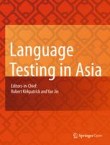References
Examples of the American Psychological Association (APA) reference style are shown below. For further guidance, see the Publication Manual of the American Psychological Association and the respective web site of the Association (http://www.apastyle.org/).
See our editorial policies for author guidance on good citation practice.
Web links and URLs: All web links and URLs, including links to the authors' own websites, should be given a reference number and included in the reference list rather than within the text of the manuscript. They should be provided in full, including both the title of the site and the URL, as well as the date the site was accessed, in the following format: The Mouse Tumor Biology Database. http://tumor.informatics.jax.org/mtbwi/index.do. Accessed 20 May 2013. If an author or group of authors can clearly be associated with a web link, such as for weblogs, then they should be included in the reference.
Example reference style:
Article within a journal
Harris, M., Karper, E., Stacks, G., Hoffman, D., DeNiro, & R., Cruz, P. (2001). Writing labs and the Hollywood connection. Journal of Film Writing, 44(3), 213-245.
Article by DOI (with page numbers)
Slifka, M.K., & Whitton, J.L. (2000). Clinical implications of dysregulated cytokine production. Journal of Molecular Medicine, 78(2), 74-80. doi:10.1007/s001090000086.
Article by DOI (before issue publication and without page numbers)
Kreger, M., Brindis, C.D., Manuel, D.M., & Sassoubre, L. (2007). Lessons learned in systems change initiatives: benchmarks and indicators. American Journal of Community Psychology. doi: 10.1007/s10464-007-9108-14.
Article in electronic journal by DOI (no paginated version)
Kruger, M., Brandis, C.D., Mandel, D.M., & Sassoure, J. (2007). Lessons to be learned in systems change initiatives: benchmarks and indicators. American Journal of Digital Psychology. doi: 10.1007/s10469-007-5108-14.
Complete book
Calfee, R.C., & Valencia, R.R. (1991). APA guide to preparing manuscripts for journal publication. Washington, DC: American Psychological Association.
Book chapter, or an article within a book
O'Neil, J.M., & Egan, J. (1992). Men's and women's gender role journeys: Metaphor for healing, transition, and transformation. In B.R. Wainrib (Ed.), Gender issues across the life cycle (pp. 107-123). New York: Springer.
Online First chapter in a series (without a volume designation but with a DOI)
Saito, Y., & Hyuga, H. (2007). Rate equation approaches to amplification of enantiomeric excess and chiral symmetry breaking. Topics in Current Chemistry. doi:10.1007/128_2006_108.
Complete book, also showing a translated edition [Either edition may be listed first.]
Adorno, T.W. (1966). Negative Dialektik. Frankfurt: Suhrkamp. English edition: Adorno, TW (1973). Negative Dialectics (trans: Ashton, E.B.). London: Routledge.
Online document
Abou-Allaban, Y., Dell, M.L., Greenberg, W., Lomax, J., Peteet, J., Torres, M., & Cowell, V. (2006). Religious/spiritual commitments and psychiatric practice. Resource document. American Psychiatric Association. http://www.psych.org/edu/other_res/lib_archives/archives/200604.pdf. Accessed 25 June 2007.
Online database
German emigrants database (1998). Historisches Museum Bremerhaven. http://www.deutsche-auswanderer-datenbank.de. Accessed 21 June 2007.
Supplementary material/private homepage
Doe, J. (2006). Title of supplementary material. http://www.privatehomepage.com. Accessed 22 Feb 2007.
FTP site
Doe, J. (1999). Trivial HTTP, RFC2169. ftp://ftp.isi.edu/in-notes/rfc2169.txt. Accessed 12 Feb 2006.
Organization site
ISSN International Centre (2006). The ISSN register. http://www.issn.org. Accessed 20 Feb 2007.
